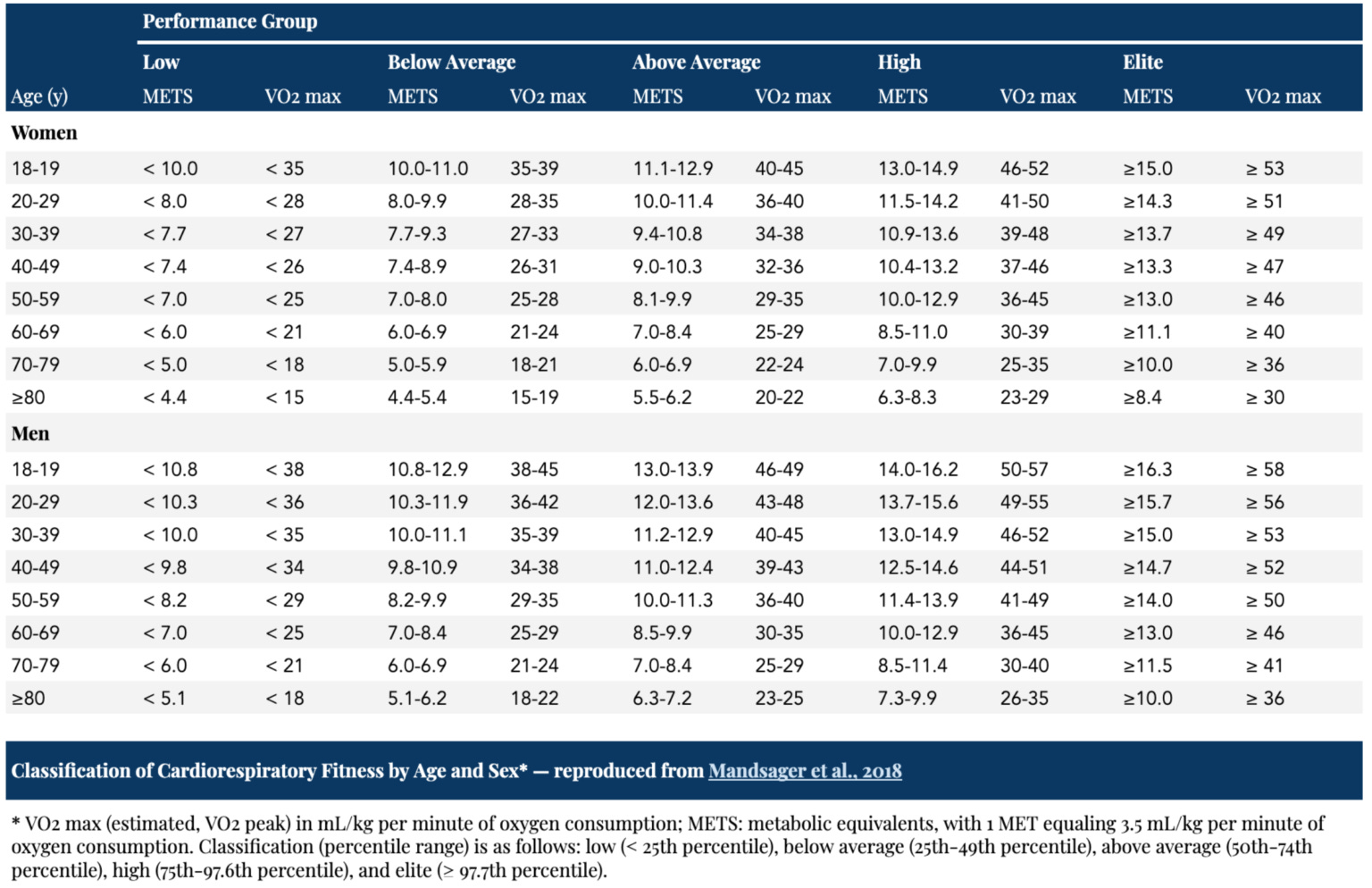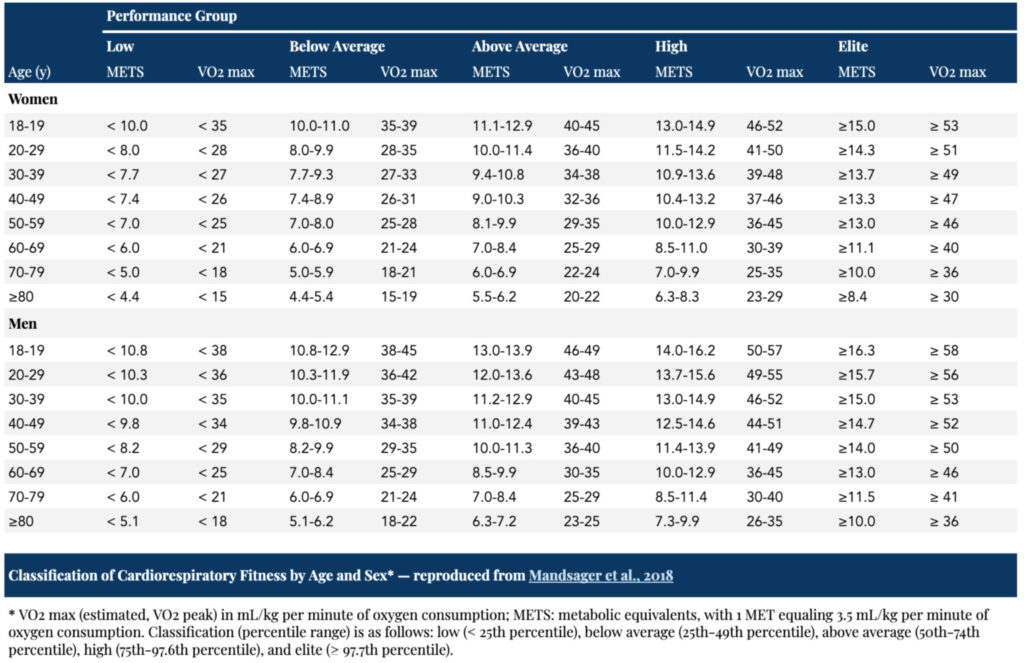Regardless of what a client’s focus is for fitness, personal trainers can and should stress the importance of sustaining and building cardiorespiratory and cardiovascular capacity. Let’s discuss how VO2 Max for healthspan plays a role in this endeavor.
VO2 Max Factor
The number one cause of mortality in America continues to be heart disease. And, many heart conditions can be avoided or mitigated with carefully planned and executed aerobic activities over the long term1.
VO2 Max – which is shorthand for the maximum volume of consumed, distributed, and used oxygen per minute – is not solely a predictor of performance for endurance athletes; It is a fine estimator for longevity and healthspan.
This article provides operational conditions for our MAX factor. It describes both formal measures and surrogate estimators to gauge aerobic capacity and healthspan. Encouragement for both professional trainer and client to take a noteworthy Norwegian online quiz to estimate one’s longevity or healthspan based on aerobic capacity is offered.
What does it take to gauge VO2 MAX?
Measured VO2 Max is part inhalation, part pump, part distribution, and part muscle utilization. There are two grades of VO2 max – one relative calculation which takes body weight into account, and one absolute figure that ignores a person’s body mass to focus on maximal oxygen absorption.
- As a practical metabolic measure for this Absolute VO2 max – about five (5) dietary calories (Kcal) are used with each Liter of Oxygen inhaled during the VO2 max evaluation period.
A key for both techniques is that maximum oxygen use is a systematic stamina process with profound implications.
Criteria to measure VO2 max and protocol benchmarks include:
- Progressively increase the intensity of aerobic effort: a perceived exertion level (RPE) of 17 or greater is reached, with a plateau of oxygen consumption and “capped” peak exertion
- Heart rate at the VO2 max plateau is within ~ 10 beats per minute of maximum heart rate (MHR)
- Relative gas exchange – when more carbon dioxide is exhaled than air inhaled with extended exertion
- The test time to achieve VO2 max can be as little as 12 minutes or as many as 45 minutes.
The Gold Standard
Elite (or simply wealthy) athletes can be tested for VO2 Max in an equipped laboratory via an instrumented treadmill, or a specially calibrated exercise cycle. These Gold Standard tests can be costly, difficult to administer, and they are not suitable for all fitness levels2. These solid gold protocols directly measure oxygen consumption at progressive workloads, including maximal exertion. Formal calculations follow to show both relative and/or absolute VO2 max for the tested athlete.
Proxy Silver Techniques
Four viable and practical “silver” estimations for one’s VO2 Max are cheaper and more convenient than that Gold Standard test measure. These proxies are good enough to gauge cardiovascular and cardiorespiratory fitness vis-à-vis others of the same age and gender demographic. They can be performed at sub-maximal efforts, which have merit for many clients.
Additionally, in our contemporary age of “smart” fitness watches and rings, proxy estimations of VO2 Max can also be provided by these devices3.
1. Estimation based on Heart Rates
- VO2 max = 15 x (HRmax/HRrest).
-
- Note that this proxy does not fully account for body mass, gender, or age. Yet, it does not require a physical test to generate a VO2 max estimate.
Example: An elite Master’s athlete has a resting HR of 41 beats per minute and a previously recorded maximum HR of 178. This proxy yields an estimated Absolute VO2 max of 15 x (178/41) or ~ 65 .
2. Rockport Walking Fitness Check:
- Estimate VO2 max with this practical relationship:
VO2 = 133 – (0.08 x bodyweight in lb) – (0.39 x age) + (6.3 x gender) – (3.26 x Mile walk time in minutes) – (0.16 x heart rate). If you are male, use the number 1, if you are female, use the number 0 for the gender calculation.
- Example: A 26 year-old male who weighs 160 pounds, walks a measured mile in 15 minutes, and has a heart rate of 120 bpm at the end.
- VO2 Max estimate = 133 – (0.08 x bodyweight in lb) – (0.39 x age) + (6.3 x gender) – (3.26 x walk time in minutes) – (0.16 x heart rate)
- VO2 = 133 – (0.08 x 160) – (0.39 x 26) + (6.315 x 1) – (3.26 x 15) – (0.16 x 120 finishing HR)
- VO2 Max estimate = (133 – 12.8 – 10.1 + 6.3 – 49 – 19) or about 49 mL/kg/min.
This male’s VO2 max is considered to be in the Very Active or Excellent range. For context, a sedentary adult male from age 18-45 has a nominal VO2 max of about 38-40 mL/kg/min. Average female adults that are sedentary have lower values than males of about 30 mL/kg/min. This gender difference for VO2 max is consistent for all age groups and fitness levels.
3. BYU 1 Mile Jog Check (gender-specific)
Be sure to use the proper equation based on the client’s biological gender.
- Women: 100.5 – (0.164 x weight in kg) – (1.44 x jog time for 1 mile) – (0.19 x heart rate)
- Men: 108.8 – (0.164 x weight in kg) – (1.44 x jog time) – (0.19 x heart rate).
Age is accounted for when the resultant estimate of VO2 max is compared to formal and published tabular entries.
4. 3-Minute or 5-minute Harvard Step Test
Healthspan and VO2 Max
“So what number (sic VO22 max) should you be striving for? Doctor Peter Attia’s aspiration to optimize longevity is for his patients to be in the “elite” category for someone a decade younger.” 5 Thus, a 50-year-old female client just might optimize her longevity by being in the elite VO2 max range of a forty-year-old female.

Summary
The VO2 max value is not a be-all or end-all performance indicator. An athlete’s mental and physical factors also contribute to superior athletic achievement in endurance events. So, the highest VO2 max doesn’t always win the Tour D France yellow jersey or Gold in an Olympic Nordic event. Additional factors of altitude, genetics, and temperature can be added to gender and age as contributors to a client’s VO2 max. And this valuable measure of oxygen absorption to do work can be confusing.
Why? An elite client athlete will be less likely to improve her or his VO2 max rating than an average or sedentary person can improve over time.
Should a client be interested in long healthspan and/or reducing morbidity in a next decade, then VO2 max is a fine and defensible measure of cardiovascular health and longevity.
References:
(1) Tian, Danyang, and Jinqi Meng. “Exercise for Prevention and Relief of Cardiovascular Disease: Prognoses, Mechanisms, and Approaches.” Oxidative medicine and cellular longevity vol. 2019 3756750. 9 Apr. 2019, doi:10.1155/2019/3756750
(2) Levine, Benjamin D. “.VO2max: what do we know, and what do we still need to know?.” The Journal of physiology vol. 586,1 (2008): 25-34. doi:10.1113/jphysiol.2007.147629
(3) Webster, D. E., Tummalacherla, M., Higgins, M., Wing, D., Ashley, E., Kelly, V. E., McConnell, M. V., Muse, E. D., Olgin, J. E., Mangravite, L. M., Godino, J., Kellen, M. R., & Omberg, L. (2021). Smartphone-Based VO2max Measurement With Heart Snapshot in Clinical and Real-world Settings With a Diverse Population: Validation Study. JMIR mHealth and uHealth, 9(6), e26006. https://doi.org/10.2196/26006
(4) https://www.ntnu.edu/cerg/vo2max
(5) https://www.theproactiveathlete.ca/survival-of-the-fittest-vo2-max-as-a-primary-marker-for-longevity/



